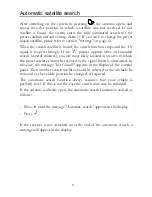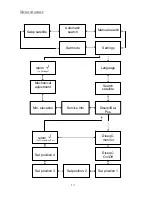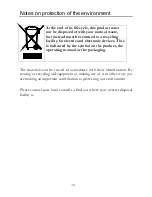
19
Programming:
A requirement for successful configuration is that channels of the
desired receivable satellites are already stored in your receiver. If this is
not the case, you will need to store the channels first. To do this, search
for the relevant satellite with your CARO by selecting the relevant search
satellite (see page 14) and using the automatic search.
Once the satellite has been found, start the channel scan function on
your satellite receiver. Please refer to the manual of your receiver for
further information. Next, you need to assign a so-called DISEqC
position to this satellite in your receiver. For this procedure, please also
refer to the manual of your receiver.
Example: The user wishes to be able to select two satellites via the DISEqC system.
The first satellite is to be Astra 1, the second Eutelsat-Hotbird. . If the channels of
these two satellites are not stored in your receiver, a channel scan must be performed
after the antenna has automatically moved into the positions of the respective satellites.
After having stored the channels of the satellites in the receiver, each satellite is
assigned a position.
In the settings menu of most standard receivers, this would appear as follows:
Satellite 1 ASTRA1 DISEqC: A
Satellite 2
ASTRA2
DISEqC: B
After storing the positions, exit the settings menu of the receiver and
select a stored channel.
Next, verify the correct function of your system by selecting the menu
option "DISEqC Monitor" in the control panel of the CARO system
(see "Menu structure" on page 13).
The display now shows a sequence of numbers and letters, of which only
the left-hand character, i.e. the satellite position, is currently of interest
Information displayed at the CARO control panel:



























